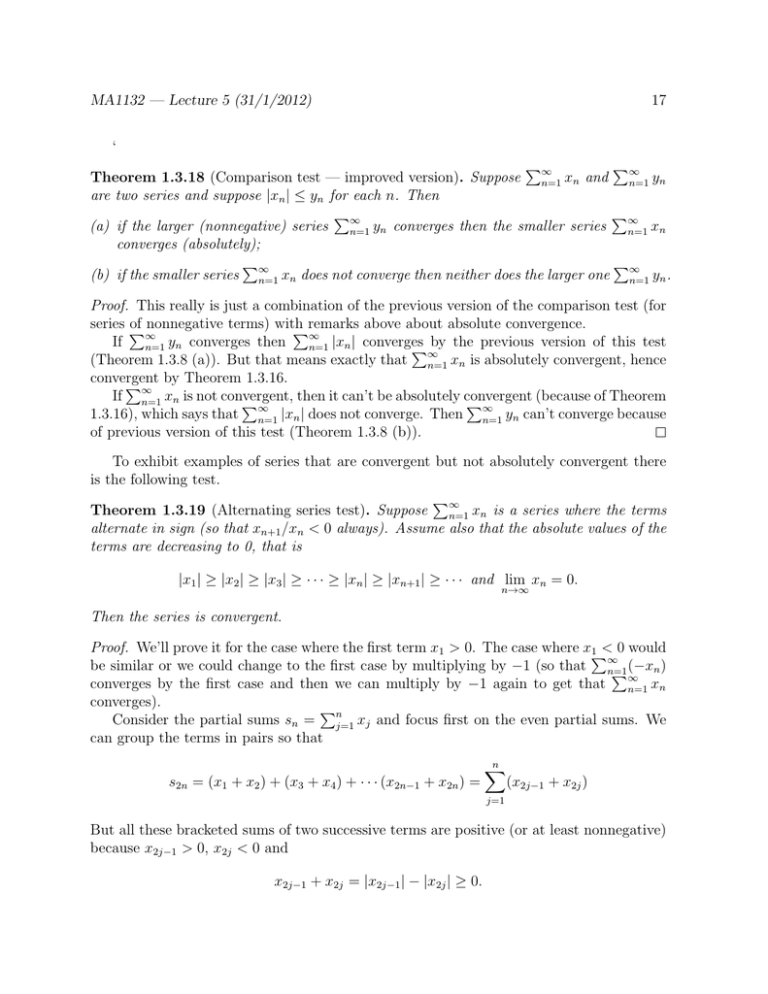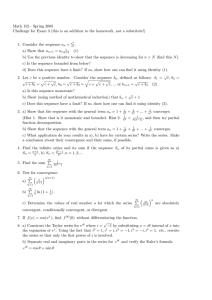MA1132 — Lecture 5 (31/1/2012) 17 ‘ P
advertisement

MA1132 — Lecture 5 (31/1/2012) 17 ‘ P P∞ Theorem 1.3.18 (Comparison test — improved version). Suppose ∞ n=1 xn and n=1 yn are two series and suppose |xn | ≤ yn for each n. Then P P∞ (a) if the larger (nonnegative) series ∞ n=1 yn converges then the smaller series n=1 xn converges (absolutely); P P∞ (b) if the smaller series ∞ n=1 xn does not converge then neither does the larger one n=1 yn . Proof. This really is just a combination of the previous version of the comparison test (for series P of nonnegative terms) with above about absolute convergence. Premarks ∞ ∞ If n=1 yn converges then n=1 |xn | converges P by the previous version of this test (Theorem 1.3.8 (a)). But that means exactly that ∞ n=1 xn is absolutely convergent, hence convergent by Theorem 1.3.16. P then it can’t be absolutely convergent (because of Theorem If ∞ n=1 xn is not convergent, P∞ P∞ 1.3.16), which says that n=1 |xn | does not converge. Then n=1 yn can’t converge because of previous version of this test (Theorem 1.3.8 (b)). To exhibit examples of series that are convergent but not absolutely convergent there is the following test. P Theorem 1.3.19 (Alternating series test). Suppose ∞ n=1 xn is a series where the terms alternate in sign (so that xn+1 /xn < 0 always). Assume also that the absolute values of the terms are decreasing to 0, that is |x1 | ≥ |x2 | ≥ |x3 | ≥ · · · ≥ |xn | ≥ |xn+1 | ≥ · · · and lim xn = 0. n→∞ Then the series is convergent. Proof. We’ll prove it for the case where the first term x1 > 0. The case where xP 1 < 0 would be similar or we could change to the first case by multiplying by −1 (so that ∞ (−xn ) n=1 P∞ converges by the first case and then we can multiply by −1 again to get that n=1 xn converges). P Consider the partial sums sn = nj=1 xj and focus first on the even partial sums. We can group the terms in pairs so that s2n = (x1 + x2 ) + (x3 + x4 ) + · · · (x2n−1 + x2n ) = n X (x2j−1 + x2j ) j=1 But all these bracketed sums of two successive terms are positive (or at least nonnegative) because x2j−1 > 0, x2j < 0 and x2j−1 + x2j = |x2j−1 | − |x2j | ≥ 0. MA1132 — Lecture 5 (31/1/2012) 18 Therefore the sequence of even partial sums (s2n )∞ n=1 is monotone increasing. If we can show that it is bounded above then the even partial sums will have a limit and we will be nearly done. If we look at the odd partial sums in a similar way we see that they can be written s2n−1 = x1 + (x2 + x3 ) + (x4 + x5 ) + · · · + (x2n−1 + x2n−1 ) and the bracketed sums of two successive terms are now all negative (or not positive because x2j−2 + x2j−1 = −|x2j−1 | + |x2j | ≤ 0). So they are decreasing x1 = s1 ≥ s3 ≥ s5 ≥ · · · . Now s2n = s2n−1 + x2n ≤ s2n−1 ≤ s1 = x1 and so the even partial sums are bounded above (by the first term x1 ). So lim s2n n→∞ exists (as a finite limit). We need to know that the odd partial sums have the same limit, but that is not so hard to see because s2n+1 = s2n + x2n+1 and limn→∞ x2n+1 = 0. Example 1.3.20. For p > 0, the series ∞ X (−1)n−1 n=1 np =1− 1 1 1 1 + p − p + p − ··· p 2 3 4 5 converges (by the alternating series test) but it is not absolutely convergent if 0 < p ≤ 1. Proof. The ratio of successive terms is negative, the absolute values |(−1)n−1 /np | = 1/np are decreasing with n and limn→∞ 1/np = 0. P p We know the series of absolute values ∞ n=1 1/n fails to converge for 0 < p ≤ 1 (see Examples 1.3.9 where p ≤ 0 is included also — but the alternating series test does P(iii) ∞ n−1 not apply to (−1) /np for p ≤ 0 because the terms don’t decrease in absolute n=1 value). P Theorem 1.3.21 (Ratio test). Suppose ∞ n=1 xn is a series and |xn+1 | n→∞ |xn | r = lim exists (as a finite nonnegative limit or as ∞). (i) if r < 1 then the series is (absolutely) convergent; (ii) if r > 1 then the series does not converge; MA1132 — Lecture 5 (31/1/2012) 19 (iii) if r = 1 no conclusion can be drawn about convergence of the series from this information alone. Note that the limit we are considering is the limit of the ratio of a term of the series to the previous one. To be more precise the absolute value of that ratio. Proof. Suppose r < 1 first. Put ρ = (1 + r)/2 so that r < ρ < 1. Since the limit of |xn+1 |/|xn | is r and r < ρ, eventually we must have |xn+1 |/|xn | < ρ. In more precise terms (by using ε = ρ − r in the ε-N definition of the limit), there is N so that |xn+1 | <ρ n>N ⇒ |xn | P∞ P∞Thenidea is to compare the series n=1 xn to a suitable multiple of the geometric series n=1 ρ . We take the mutltiple big enough to deal with all terms up to xN +1 , that is we take k= |xj | . 1≤j≤N +1 ρj−1 max So then we have |xj | ≤ kρj−1 for j = 1, 2, . . . , N + 1. We can then deduce that |xN +2 | < ρ ⇒ |xN +2 | < ρ|xN +1 | ≤ ρkρN +1−1 = kρ(N +2)−1 |xN +1 | and show by induction that |xN +j | ≤ kρ(Nj )−1 for all j ∈ N. Combining that with the way we picked k we have |xn | ≤ kρn−1 P∞ n−1 P∞ n−1 = k/(1 − ρ)), the comparison test kρ converges (it is k for all n. Since n=1 ρ n=1 P∞ tells us that n=1 xn converges (in fact converges absolutely). P √ n Example 1.3.22. For which values of x does ∞ nx converge? n=1 P th Solution: Although x is a variable, for fixed x we have a series ∞ n=1 tn where the n -term is √ tn = nxn To apply the ratio test, we should evaluate √ p |tn+1 | | n + 1xn+1 | √ n r = lim = lim = lim 1 + 1/n|x| = |x| n→∞ |tn | n→∞ n→∞ | nx | Since there is a limit we can say that the series definitely converges for |x| < 1 (that is for −1 < x < 1) and does not converge for |x| > 1. The uncertain values of x are just x = ±1. In many problems of this type, it can be difficult cases. P P∞ √ to deal with these remaining √ n However, in this example the series for x = 1 is ∞ n and for x = −1 it is (−1) n. n=1 n=1 Neither of these can converge because the terms do not tend to 0 as n → ∞. MA1132 — Lecture 5 (31/1/2012) 1.4 20 Power series Definition 1.4.1. A power series is a series of the form ∞ X an (x − a)n n=0 where x is a variable, a is a fixed point called the centre of the series and the numbers a0 , a1 , . . . are called the coefficients of the series. In series of this type it is usual to have a convention that (x − a)0 means 1, even for x = a (where it would read 00 , something that one should not normally attempt to define). So the power series means a0 + a1 (x − a) + a2 (x − a)2 + · · · When a = 0 the series looks like 2 a0 + a1 x + a2 x + · · · = ∞ X an x n n=0 √ Example 1.4.2. In the previous example we have a = 0 and an = n. We don’t have any simple formula for the sum of that series. From the formula for the sum of a geometric series we know ∞ ∞ X X 1 1 + (x − a) + (x − a)2 + · · · = (x − a)n = (x − a)n−1 = 1 − (x − a) n=0 n=1 for |x − a| < 1. (Here the coefficient of (x − a)n is an = 1 for each n ≥ 0.) We now summarise (without any attempt at a proof) some of the main facts about power series. P n Theorem 1.4.3. Let ∞ n=1 an (x − a) be a power series. (a) The series has a radius of convergence, a ‘number’ R ≥ 0 with the property that the series converges for |x − a| < R but fails to converge for any x with |x − a| > R. However the ‘number’ R may be ∞, that is it may be that the power series converges for all x. (It may also be R = 0, in which case the series converges only for x = a.) (b) If R > 0 we can define f : (a − R, a + R) → R by f (x) = ∞ X an (x − a)n n=1 The function f (x) will be diffentiable and its derivative is given by 0 f (x) = ∞ X nan (x − a)n−1 n=1 for |x − a| < R. MA1132 (R. Timoney) January 30, 2012



